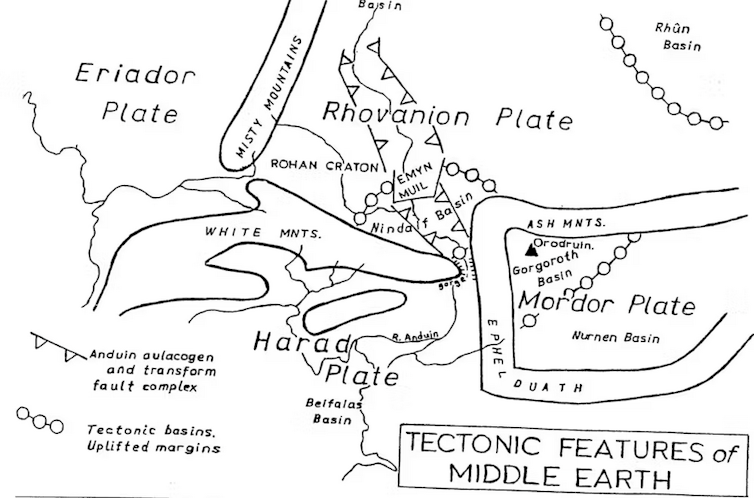Although Tolkien's world is wonderful, it is not without contradictions, especially on the geological level. Beyond any realism, the mountains, rivers and landscapes are places associated with a mythical world.
The world of J. R. R. Tolkien occupies a symbolic place in fantasy literature. Works like Lord of the Rings and The Silmarillion It showcases Tolkien's ability to create a rich world, populated by ancient civilizations, mythical creatures and stunning landscapes.
Middle-earth, with its vast expanses, majestic mountains, and mysterious forests, is the setting of an epic that continues to captivate generations of readers. Adaptations of the film by Peter Jackson These fantasies were reinforced by serials Power rings Prime Video's production continues this trend by exploring new aspects of this universe while maintaining the visual appeal and legendary depth of the original work.
However, although Tolkien's world is fascinating, it is not without contradictions, especially on a geological level. From mountains created by works of the imagination to volcanoes that defy the laws of plate tectonics, the map of Middle Earth contains elements that defy traditional scientific explanation. This article examines these contradictions in the light of modern scholarship, putting Tolkien's geographical descriptions into perspective with their interpretation in Peter Jackson's films and Prime Video series, while seeking to understand how narrative imperatives have sometimes prevailed over geological plausibility.

Provided by the author
Geology and imagination: an inevitable contradiction?
When Tolkien designed Middle-earth, he was not seeking to create a geologically accurate world, but rather to build a mythical and epic world for his stories. Inspired by ancient myths and legends, especially Norse mythology, he shaped a world governed by supernatural forces rather than natural laws. Tolkien himself recognized the geological limitations of his world, admitting in his correspondence that the geology of Middle-earth was “quite imperfect by the standards of modern science”. This indicates that scientific accuracy was not his priority; He preferred the mythical side of his world.
This choice is partly explained by the scientific context of the time. When Tolkien wrote Lord of the Rings (In the 1930s and 1940s), the theory of plate tectonics was not yet well established, and It did not become widely accepted until the late 1960s. Knowledge about mountain formation and volcanoes was limited, and Tolkien, without any training in geology, imagined a world in which the terrain was shaped by supernatural forces. But even if he had written later, at a time when plate tectonics was well known, what would have prevented him from imagining the whole thing, in a fantasy world? Was it expected to be scientifically flawless?
In this universe, mountains, rivers and forests are not simple elements of the landscape, but the fruit of great deeds or the site of legendary battles. For example, the Misty Mountains, created by Morgoth, are not the result of plate tectonics, but rather the result of a specific narrative purpose. Likewise, the destruction of Númenor and the inundation of the ancient land of Aman have more to do with mythological stories, inspired in particular by the myth of Atlantis, than with natural geological processes.
Geological contradictions in Tolkien's work
Tolkien's world presents remarkable geological contradictions, exacerbated by the author's narrative choices. Three notable examples are the Misty Mountains, Mordor and Mount Doom, as well as the White Mountains.
Misty mountains (Misty Mountains): This range extends for thousands of kilometers with an almost perfect north-south orientation. In fact, such a formation would imply a major geological fault or a long tectonic history, absent from the story. Such a vast linear mountain range would typically result from complex processes such as the collision of tectonic plates, with evidence of folding, faulting and significant deformation, which is never mentioned in Tolkien's works. The absence of these geological details suggests that these mountains were created to serve narrative purposes, not to reflect geological facts.
Mordor and Mount Doom
Mount Destiny (also translated Mount Destiny), an active volcano for thousands of years, is the only one in Mordor, which is unlikely from a geological point of view without other volcanic manifestations associated with it. The induced eruption of Mount Destiny, a central moment in the chain of power rings, is an example of how narrative can trump geological logic. In the series, this catastrophic event is deliberately triggered, showing how mythological and narrative forces shape the events, to create Mordor, while distancing themselves from real-life geological processes.

Geologically, these types of volcanoes form along convergence zones where oceanic tectonic plates slide beneath another continental plate or oceanic plate, a process called subduction. As the plate sinks into the mantle, it experiences an increase in temperature and pressure, causing it to release volatile fluids such as water. These fluids, escaping from the subducting plate, lower the melting point of the overlying mantle, leading to the formation of magma. This magma, less dense than the surrounding rocks, rises to the surface to form volcanoes. These volcanoes are often located in mountain ranges such as the Andes or island arcs such as the Lesser Antilles.

White mountains
These mountains are located in the south and are described as being permanently covered with snow, which is inconsistent with the climate of the region.
In fact, permanently snow-capped mountains are generally located at high latitudes, near the poles, or at very high altitudes where temperatures remain low throughout the year.

However, the White Mountains lie to the south of Middle-earth, in an area roughly consistent with the temperate or even subtropical climate of our world. In such an area, a mountain range is unlikely to remain permanently covered in snow unless it reaches very high altitudes, which is not the case for the White Mountains as described by Tolkien. The discrepancy between its geographical location and its permanent snow cover thus constitutes a climatic asymmetry, because a warmer and more temperate climate would make it difficult for snow to persist at moderate altitudes.
Why modifications amplify geological discrepancies
Peter Jackson movies and series Power rings I highlighted these contradictions for visual and narrative reasons. The grandiose landscapes and harsh environments, while impressive, can sometimes defy geological plausibility. For example, Mordor is depicted as a wasteland dominated by the isolated Mount Doom, creating a monumental monument at the expense of scientific credibility. The cause of the eruption of Mount Destin in the series Power ringsthe founding moment of the story, highlights this aspect by introducing an element that is startling, but implausible from a geological point of view. Likewise, the White Mountains, with their snow-capped peaks, appear more majestic on screen, highlighting the epic aspect, but distorting the climatic reality.
Tolkien's world, amplified through film and television adaptations, transcends geological facts to serve an epic narrative and a coherent mythology in its own right. If the geological inconsistencies are undeniable, they are largely compensated for by the richness of narrative and immersion that this universe provides. Peter Jackson movies and series Power ringswhile amplifying some of the contradictions, succeeds in capturing the epic essence of Middle-earth, providing a captivating fantasy world despite its scientific “flaws.”
